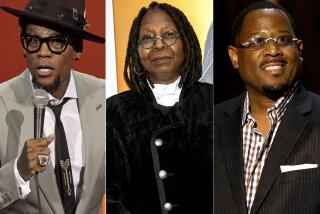A New and Changed NAACP Magazine
- Share via
BALTIMORE — The NAACP’s magazine surely won’t become a hotbed of conservatism when it resumes publication in July.
But if Paul Ruffins has his way, the Crisis will house a wide range of opinion on black American life--including thinkers whose philosophy owes more to Newt Gingrich than to W.E.B. DuBois.
“It’s OK for black people to disagree,” said Ruffins, 43, a Washington writer who is the newly named editor of the official NAACP publication. And what better place to hash out ideas, the editor asks, than the magazine founded in 1910 by DuBois, the Harvard-educated radical and civil rights godfather?
The Crisis will be appearing for the first time since March 1996, when it ceased publication as part of the National Assn. for the Advancement of Colored People’s reorganization under Chairwoman Myrlie Evers-Williams and President Kweisi Mfume.
Ruffins’ challenge with the Crisis is much like Mfume’s with the NAACP: to restore its past glory while making it relevant to a new generation of blacks focused on now, not then.
“I have been calling people across the political spectrum to say, ‘Participate; disagree with us,’ ” said Ruffins, a Harvard graduate with a master’s in psychology from Columbia.
Ruffins, who began his career as an advertising copywriter, has edited publications for the Congressional Black Caucus and a construction union. A frequent contributor to the Washington Post and Black Issues in Higher Education, he started Black Networking News, a short-lived Washington monthly.
The NAACP “can be an honest broker of ideas,” Ruffins said. Despite its recent history of financial mismanagement, he said, people still trust the 88-year-old civil rights group.
Julian Bond, a veteran civil rights figure, has overseen the remaking of the magazine since Evers-Williams disbanded the board of the Crisis Publishing Co., a for-profit NAACP subsidiary, and named him chairman.
In Bond’s view, the Crisis had become a “consumer magazine whose articles could have appeared in Ebony. This magazine was once the place where you read about race, and the new board wanted to make it that again.”
Mfume, a member of the new board, said he wanted a high-quality publication that was “hard-hitting” and unafraid of controversy.
George Curry, editor in chief of the 160,000-circulation news magazine Emerge, said the Crisis has the advantage of a built-in audience (more than 300,000 subscribers will receive the magazine as part of NAACP membership) that is attractive to advertisers.
Under DuBois, the Crisis: A Record of the Darker Races set the agenda for the fledgling NAACP. It was a publishing phenomenon. Its circulation soared from 1,000 in 1910 to more than 100,000 at the end of the decade, putting it into a league with the Nation and the New Republic, said David Levering Lewis, the Pulitzer Prize-winning biographer of DuBois. Perhaps half its readers were white.
As a repository of black thought, the Crisis had a virtual monopoly at first, Lewis said. DuBois published Harlem Renaissance writers such as Langston Hughes and Jean Toomer.
By the 1930s, however, the NAACP had become more institutional and DuBois, increasingly radical, sometimes at odds with leaders such as Walter White and Roy Wilkins. In 1934, after writing two essays in the Crisis suggesting that black separatism could be a useful economic strategy, DuBois left the magazine to return to teaching at Atlanta University.
It was not the first time that DuBois had spurred controversy in the pages of the Crisis. His debates with Booker T. Washington, who preached an accommodational philosophy of self-help for Southern blacks, remain seminal in black American thought.
If Ruffins can again make the Crisis a forum for black America, “he could really say he’s coming in where DuBois left off,” Lewis said. The historian said he promised Ruffins a short article on “what DuBois thought of the black press, which wasn’t much.”
More to Read
Sign up for Essential California
The most important California stories and recommendations in your inbox every morning.
You may occasionally receive promotional content from the Los Angeles Times.









